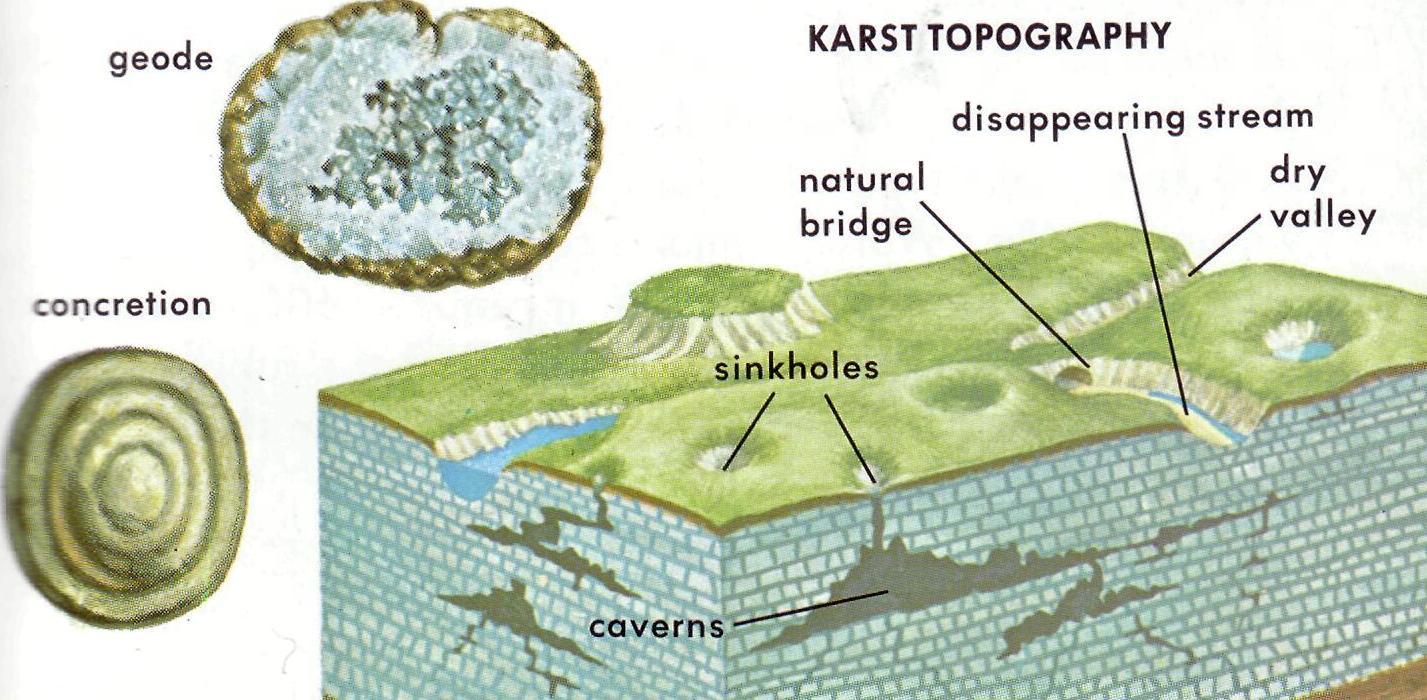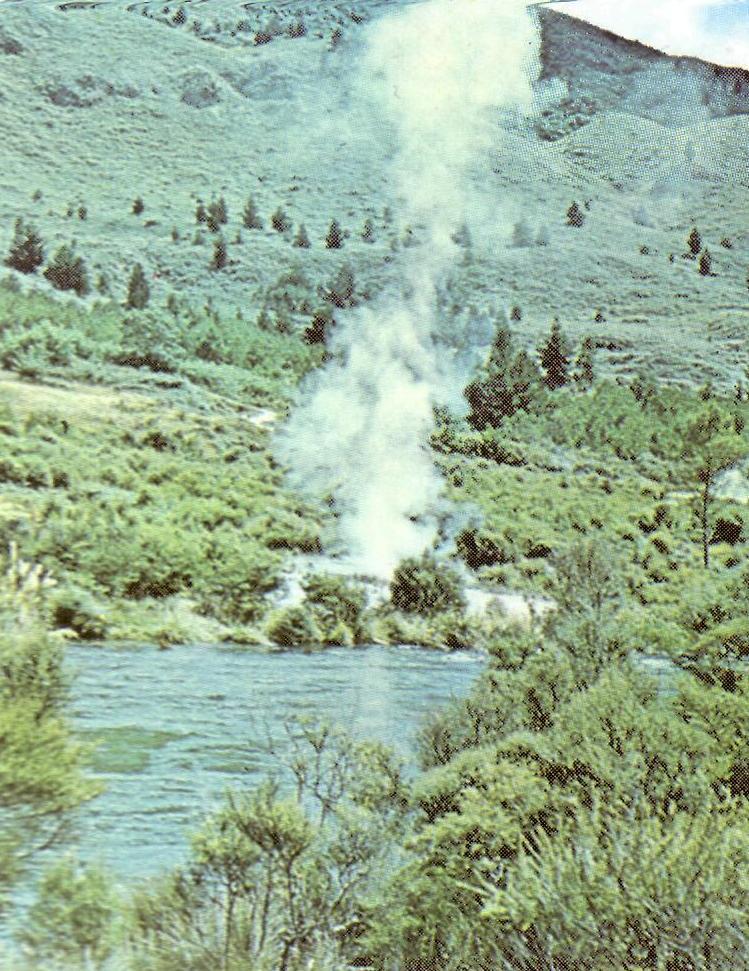
The Water Table
 The
water table depends on the distribution of groundwater. The open
spaces in the rocks of the upper part of the crust are filled mainly
with air. This is the zone of aeration. Water moves downward through
this zone into the zone of saturation, where openings are filled with
water. The upper surface of this saturated zone is the water table.
In most areas, the water table is only a few tens of feet below the
surface, but in arid regions, it is much deeper. Water-bearing rocks
are rarely found below 2.000 feet. Rock pores are closed by pressure
at depth, and this determines the lower limit for groundwater. Most
rocks will give off water whenever they intersect the water table.
But the level of the water table falls after a dry season, so rock
formations must be deep enough to penetrate the water table all year
round. Sometimes a perched water table results when a pocket of water
is held above the normal water table by a saucer of impervious rock.
Any water-producing rock formation is called an aquifer.
The
water table depends on the distribution of groundwater. The open
spaces in the rocks of the upper part of the crust are filled mainly
with air. This is the zone of aeration. Water moves downward through
this zone into the zone of saturation, where openings are filled with
water. The upper surface of this saturated zone is the water table.
In most areas, the water table is only a few tens of feet below the
surface, but in arid regions, it is much deeper. Water-bearing rocks
are rarely found below 2.000 feet. Rock pores are closed by pressure
at depth, and this determines the lower limit for groundwater. Most
rocks will give off water whenever they intersect the water table.
But the level of the water table falls after a dry season, so rock
formations must be deep enough to penetrate the water table all year
round. Sometimes a perched water table results when a pocket of water
is held above the normal water table by a saucer of impervious rock.
Any water-producing rock formation is called an aquifer.
Exercise 6. Answer the following questions using information from the text above:
The water table depends on the distribution of groundwater, doesn’t it?
Are the open spaces in the rocks of the upper part of the crust filled with water?
Which is the aeration zone?
Where does water move?
What is the water table?
The water table is only a few tens of feet below the surface everywhere on earth, isn’t it?
How deep are water-bearing rocks found?
Why are rock pores closed at depth?
The lower limit for groundwater is determined by the water circulation process, isn’t it?
When will most rocks give off water?
When does the level of the water table fall?
When does a perched water table occur?
Part 2. Geysers
Study the list of vocabulary and pronounce the words after the teacher:
Vocabulary:
to confine – ограничивать
permeable [’pə:mjəbl] – проницаемый, проходимый, негерметичный, пропускающий
catchment [’kæt∫mənt] – дренаж
intake – втягивание, всасывание, потребление, водозабор, головное сооружение канала
well head – источник, родник, ключ
internal [in’tə:nl] – внутренний
artesian well [a:’ti:ziən] – артезианский колодец
spring – родник
fumarole [’fju:mərəul] – фумарола (разновидность гейзеров)
to depress [tə di’pres] – понижать, ослаблять
to flow – течь, струться
interruption [‚intə’rлp∫(ə)n] – перерыв, пауза, приостановка
volcanism [’vɔlkəniz(ə)m] – геол. вулканизм, вулканические явления
terrace [’terəs] – насыпь, уступ в скалах, терраса deposit – геол. отложение, месторождение, залежь
mammoth [’mæməθ] – мамонт; гигантский, громадный
calcium carbonate [’kælsiəm ’ka:bən(e)it] – карбонат
кальция
travertine [’trævətin] – мин. травертин, известковый туф, белый итальянский известняк
geyser [’gi:zə] – гейзер
intermittent [‚intə(:)’mit(ə)nt] – перемежающийся, скачкообразный, прерывистый, периодический, пульсирующий
fountain [’fantin] – ключ, фонтан
cone [kəun] – конус; конусообразный, конический
siliceous [si’l∫iəs] – хим., геол. кремнистый
geyserite [’gi:zərait] –
to emit [tə i’mit] – выбрасывать, извергать
f umes
(usually
pl.)
[fju:mz] – испарение,
пары
umes
(usually
pl.)
[fju:mz] – испарение,
пары
thermal [’θə:m(ə)l] – тепловой
to discharge [tə dis’t∫a:dჳ] – выпускать, извергать, выстреливать
explosive violence [iks’pləusiv ’vaiələns] – взрывная сила
v ent
– отверстие, выход
ent
– отверстие, выход
bubble [’bлbl] – пузырёк с воздухом, бульканье
to relieve [tə ri’li:v] – освобождать, сменять
fissure [’fi∫ə] – трещина, расщелина, излом
extending – вытягивание, удлинение
to erupt [tə i’rлpt] – извергать, выбрасывать
enlargement [in’la:dჳmənt] – расширение, увеличение
stalagmite [’stæləgmait] – сталагмит
stalactite [’stæləktait] – сталактит
karst topography [’ka:st tə’pɔgrəfi] – геол. карстовый рельеф
sink – геол. карстовая воронка, низина, сточная труба
calcite [’kælsait] – кальцит, известковый шпат
to drip – капать, падать каплями
icicle-shaped formation [’aisik(ə)l ∫eipt] – образование в форме сосульки
ceiling [’sili:ŋ] – потолок
deposition – отложение
replacement – замена, замещение
cementation – цементирование, скрепление; хим. осаждение металла из раствора
concretion [kən’kri:∫(ə)n] – геол. сращение; конкреция, минеральное включение
hollow [’hɔləu] – пустой, полый; низина, ложбина
globular [’glɔbjulə] – шаровидный, сферический
geode [’dჳiə:ud] – геол. жеода
to surge [tə sə:dჳ] – подниматься, вздыматься, хлынуть
upward [’лpwəd] – направленный вверх, поднимающийся
dissoluble – нерастворимый
pungent [’pлndჳ(ə)nt] – едкий
sinter [’sintə] – натёк, туф
Exercise 1. Match the words on the left with their definitions on the right:
Nouns:
1. spring a. pungent smoke or vapour
2. geyser b. place where water is coming up from the ground
3. bubble с. long narrow crack
4. fissure d. a ball of air in a liquid
5. stalagmite e. spring that discharges steam and hot water
6. fumes f. lime deposit sticking up from the floor of the cave
Verbs:
1. to depress a. to discharge steam, water or volcanic materials violently
2. to erupt b. to move strongly up
3. to surge c. to lower, to push down
4. to flow d. to limit bounds; to restrict the free movement
5. to drip e. to move in a stream
6. to confine f. to fall in drops
Adjectives:
1. permeable a. occurring at intervals
2. internal b. heated; hot or warm
3. intermittent c. having space inside
4. thermal d. capable to pass, flow or spread into every part
5. hollow e. sphere-like; round
6. globular f. of or on the inside
Exercise 2. Read the following text “Geysers” and fill in the gaps with the words given below and then translate it into Russian:

